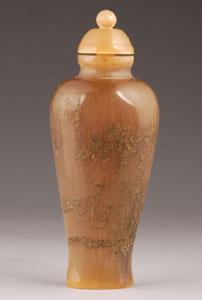Materials
Extraordinary is the range of materials to produce snuff bottles. The artefact is never considered precious on account of precious material used, but on account of the quality of décor and execution. Semiprecious material was also considered because it was hard to find. For instance, some jade, jadeite and hornbill (ivory obtained from “Bucerus” peck or hornbill).
Commonly used materials were:
- Natural materials of inorganic origins, stones that I find easier to divide in three groups, on account of the way they were considered. Highest range such as (they bear a rich and particular repertoire): nephritis or jade, jadeite, quartz, chalcedony, variety of agate, jasper, (those last two stones being a variety of chalcedony) Pudding stone, and Fossilliferous Limestone (the last two being quite rare stones, but very much sought-after for their beauty).
Hard stones generally, less various than the previous group: Aragonite, Fluorite, Obsidian, Ink Stone, Duan Stone, Basaltic Rocks, “Hen’s Blood” Stone, Soap Stone, Cornel (another variety of chalcedony).
Semi-precious stones, less various than the previous group, such as: Turquoise, Malachite, Lapis Lazuli, Aquamarine, Tourmaline, Beryl, Amethyst and Purple Quartz. - Natural materials from organic compound sources, (even fossils): Ivory, from Elephant but even from Walrus tusks, Narvalus tusks, Hornbill, horns from other animals (buffalo, buck, antelope, rhino), Amber, Coral, Gourd, Wood, Bone, Walnut Shell, Lacquer, Shagreen, Mother-of-Pearl, Jet, Turtle, Seeds, Beeswax.
- Metal: Silver, Brass, Copper (used as basis to enamel and lacquer ware).
- Metal alloys: Bronze, Pewter, Bai Tong.
- Artificial materials: such as Porcelain, Gres, Silk with Lacquers layers, glass of every kind.
Graphic diagram about different shapes








